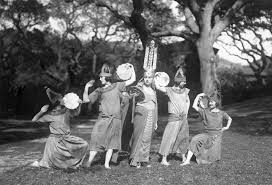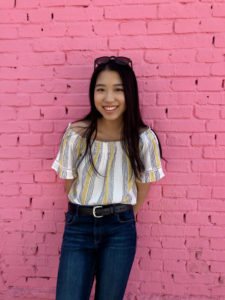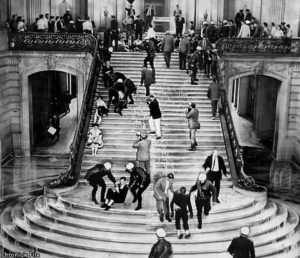Tag: 150 years of women at berkeley
Lucy Sprague Mitchell: Child Education Reformer and Berkeley’s First Dean of Women
By Deborah Qu
“It was naive, but it wasn’t as naive as it sounds.” — Lucy Sprague Mitchell on chasing her dream to expand career prospects for women
One hundred and fifty years ago in 1870, the UC Regents first declared that the university’s doors were open to women students, giving them the opportunity to pursue a higher education. Access to student facilities, housing, and resources were still far from equal for women. Thus began an era where thousands of young women pioneered for positive change, making their mark on the university, as well as transforming society at large. One of these women was Lucy Sprague Mitchell, the first dean of women from 1906–1912, and one of the first women instructors in UC Berkeley’s Department of English. Mitchell, an advocate for educational reform, had observed that “public opinion reacts very slowly. And there’s always been something that irritates me, and that is the voices against are so much louder than the voices for.” Yet her unrelenting optimism and her passion for education allowed her to introduce a more holistic framework for child learning and expand career prospects for women outside the limited field of teaching.

Born in 1878, Lucy Sprague Mitchell grew up in a traditional household where any sort of play was seen as “a waste of time.” In a 1962 interview with the Oral History Center of The Bancroft Library, Mitchell recalls a multitude of happy childhood memories, but they were also mixed with conflicting feelings of unworthiness and loneliness caused by her family’s strict Puritan modes of discipline. It is possible that these childhood learning experiences were great influencers in her later experimental work in education. In her autobiography, Two Lives: The Story of Wesley Clair Mitchell and Myself, she explained how she believed that the entire learning process is not complete without the “intake” of experience transforming into an “outgo,” or some living, creative action caused from the development. Perhaps these mixed childhood memories had also inspired her to take positive action through childhood education reform.
After graduating from Radcliffe College, Lucy Sprague Mitchell was appointed as Berkeley’s first dean of women at only age 23. In her oral history, Mitchell recalled a conversation she had with the university President Benjamin Ide Wheeler. His instructions were “to find out what needs to be done and to do it.” While terrified and confused, this is exactly what Mitchell did. As dean of women, Mitchell did not succumb to the “motherly” role to students that was expected of her in the early 1900s. Instead her youthful perspective allowed her to expand beyond the traditional housing and counseling needs to truly connect with students at Cal. She initiated community trips, poetry readings, and sex education discussions. She organized Parthenia, which she fondly called greek for “women of the Parthenon,” a performative showcase about various historical women and imagined female characters.

In her oral history, Mitchell reflected on why she wanted to leave her role as dean of women; Mitchell explained that her interests truly were rooted in education, not administration. During her years working with women students, she had become, she says, “extremely concerned about the lack of professional training for women excepting in the field of teaching. She explained how “not everybody is equipped to be a teacher, nor wants to be a teacher.” At the time, Mitchell found it jarring that over 90 percent of the women students she surveyed had planned to become a teacher after graduation. While Cal was progressive for its time, teaching was the most socially acceptable profession and “the only thing that the University offered to women.” In retrospect, Lucy Sprague Mitchell believed that her real reason for requesting a leave from Berkeley “was to try to explore different fields of work that women could enter and for which the University could train them.”
This disaffection inspired innovation. Lucy Sprague Mitchell brought the issue of limited education for women to six social organizations in New York, completing statistical fieldwork from women working in nursing, to labor legislation about city tenements, to public schools. Her exposure to public school education had such a profound effect on Mitchell that she became an educator resource for teachers throughout 1922–1955. She began developing experimental methods about childhood education and classroom procedure that promoted creative expression and holistically fulfilled a child’s emotional, physical, and mental needs. Her emphasis on “relationship teaching” and “active learning” over memorization helped shape the way for “social studies,” a course widely studied in American classrooms today. Her focus on the learning environment was unorthodox at the time, and it led her to new paradigms of using childhood maturity instead of age to measure emotional intellectual development. She founded Bank Street College of Education in New York as a graduate student teacher training institution in 1916 based on this same philosophy.

From my perspective as an undergraduate student at Cal, Lucy Sprague Mitchell’s life story teaches me that to truly orchestrate change, we should not just be focusing on the various problems of the present, but rather dreaming about all the future potential. The oral history interview allowed Lucy Sprague Mitchell to recount the early dream she had formed working with Cal students in her late 20s: to provide opportunities for young women to pursue rich and nuanced fields of study. This dream certainly did not go to waste. As a young college woman with a wide selection of majors to choose from, I am grateful that she and many others helped pave the way. Reflecting on this vision for women, Lucy Sprague Mitchell said, “Now that sounds very naive. It was naive, but it wasn’t as naive as it sounds.”
Deborah Qu is a first year undergraduate student who intends to study psychology. As a part of the celebration of 150 years of women at Berkeley, Deborah is researching the Oral History Center’s vast archive to identify women in the collection with a relationship to UC Berkeley.
Find this and all our oral histories from the search feature on our home page. You can search by name, key word, and several other criteria.
“They Got Woken Up”: SLATE and Women’s Activism at UC Berkeley

For students across the country, college is a time of political awakening. And perhaps no other university has earned its reputation for radical student politics quite like UC Berkeley. Indeed, mid-century political activism around civil rights, the Vietnam War, and the Free Speech Movement has shaped how students, faculty, and administrators experience life at Berkeley today.
However, one important part of Berkeley’s political history that often gets left out of the conversation is the New Left student political party SLATE. SLATE — so named because the group backed a slate of candidates who ran on a common platform for ASUC (Associated Students of the University of California) elections — operated between 1958 and 1966, and ignited a passion for politics in the face of looming McCarthyism and what many perceived as the University of California’s encroachment on student rights to free speech. These students translated political theory they learned in the classroom to action, even when it went against University policies. Perhaps SLATE’s most important ideological contribution to Berkeley’s campus and to other social movements is the “lowest significant common denominator.” This concept allowed the group to form a big tent coalition between Marxists, liberal Democrats, and others by only choosing political positions and actions that the whole group could agree on. As a result, the group became involved with civil rights, labor organizing, and anti-war protests on campus and across California. Most notably, in May of 1960, SLATE and other student activists protested the HUAC (House Un-American Activities Committee) hearings at the San Francisco City Hall. In response to the peaceful sit-in, police blasted students with fire hoses and dragged them down stairs before placing them under arrest. This event was emblematic of SLATE’s commitment to activism, even when it came at personal risk.
In recent years, the Oral History Center of the Bancroft Library has conducted a series of interviews with members of SLATE to keep alive memories of the group’s influence on ideology and political infrastructure at UC Berkeley.
An essential part of SLATE’s story is the contributions of its women members. SLATE operated at a time before the women’s movement, but its work became an important introduction to political organizing for a generation of women students at Berkeley. These women were dedicated members of the group, but often felt sidelined in SLATE leadership. And yet, their work helped to change political culture and campus life at Berkeley. Three of these groundbreaking Berkeley women are Cindy Lembcke Kamler, Susan Griffin, and Julianne Morris.
Cindy Lembcke Kamler was just a freshman when she connected with SLATE in the spring of 1958, drawn in by the political ideals of the group dominated by male upperclassmen and graduate students. Susan Griffin and Julianne Morris were among the second generation of SLATE activists and joined the group around the same time in 1960 — after the famous HUAC protest.
All of these women came from politically left families who feared encroaching McCarthyism. Griffin and Morris also had connections to Judaism. These backgrounds helped ignite a political consciousness in these women that led them to SLATE.
Certainly Kamler, Griffin, and Morris’s oral histories contribute to the larger archive of SLATE history, but they also speak specifically to their experiences as women in this group. For instance, Griffin and Morris recalled instances of feeling marginalized and of being left to do what Morris called the “scut work,” like mimeographing fliers and cooking for hungry activists. This work, while essential to maintaining operations, felt to them like gendered tasks. For her part, Kamler doesn’t remember gender discrimination in SLATE. She insisted, “Oh, no, I never made coffee or any of that stuff.” And yet, Griffin recalled that several years later at a meeting of SLATE women in the 1970s,
“We were recounting how there was this prejudice against us and we were never allowed to have leadership positions. And husbands and boyfriends and guys from SLATE showed up at this meeting and started making fun of us and broke the meeting up. They thought that was the end of the story. Little did they know, [laughs] that was just the beginning of the story.”
These tensions came to a head at a 1984 SLATE reunion in which women newly empowered by feminism expressed displeasure with the way they had been treated while working for the campus political group. Many of the men denied there had been discrimination, but others took it to heart and sincerely apologized. Morris explained, “There were a lot of women who were really angry about how it had been. I don’t know that I was angry, in the sense that I really felt it was a different time and one can’t judge one time by another. But there was no question that that’s the way it was, and that’s what kind of was accepted.” Watching these events unfold, Kamler recalled, “I was just sitting there stunned. I didn’t do any of that stuff. I ran for office, I got elected, I was chairperson.”
Indeed, while there may have been invisible barriers for many of the women involved in SLATE, there were still opportunities to grow as individuals and leaders. Kamler ran for second vice president in the spring of 1958 and lost, but ran again for representative-at-large in spring of 1959 and won. She also served as the chair of SLATE for some time, helping to shape the group’s platform and activist agenda. Even Griffin and Morris were encouraged to run for ASUC office in the early 1960s, and had to learn how to campaign and feel confident in public speaking. Morris especially found running for office to be a formative experience. She remembered,
“And that was, for me, a big experience, because as I said, I was shy in terms of speaking out and I didn’t think that I could do it. And Mike Miller kept urging me to do it and saying, ‘You can do this. I’ll help you if you want, but you can do this! You’re going to be able to go to all of these fraternities and talk to them about ROTC. I just know you can do it.’ So I did it, and I really was very frightened about doing it, and I actually did fine. So that was, for me, kind of a breakthrough, that I was able to do something like that, because it wasn’t easy for me at the time.”
But as their lives became less centered around the UC Berkeley campus, these women drifted away from SLATE. Kamler married and left the group after the spring of 1960. Griffin and Morris had decreased their participation in SLATE or left campus entirely by 1964. And yet, as their oral histories reveal, the experiences these women had as Berkeley undergraduates in this student political party shaped their perspectives about politics and activism for years to come. For both Griffin and Morris, this activism took shape as involvement in the women’s movement. Griffin explained, “The guys may not have known it, but they were training feminist activists in all that period.”
Thinking about the longer arc of SLATE’s impact on the lives of its dedicated members, Morris recalled of a reunion in the 1990s:
“One of the things that we did was that we went around as a group and talked about what our lives were like now. And no one in that whole group went into business. Everybody was an organizer, a teacher, a social worker, a psychologist. It was so interesting that this group of people kind of, in some ways, stayed true to what we all went through in college. It really formed our lives.”
But most importantly, what these women learned from their time with SLATE was the importance of building and sustaining community in activist groups. For Morris, joining SLATE helped her find a place where she belonged. Griffin pointed to organizations of politically like-minded individuals as ways to create belonging and “joy” through an almost spiritual experience of protest.
And yet, the political work of Cindy Lembcke Kamler, Susan Griffin, and Julianne Morris wasn’t just personally fulfilling. For these individuals and generations of other women students, their political activism at UC Berkeley left an indelible mark on the campus. In thinking of this legacy, Morris reflected, “…it was one of the first…of the Left student movements. And I think it influenced a lot of people in that regard…I’m not at all sure that the Free Speech Movement would have happened without SLATE.” She concluded, “I think we were very successful in those years. We got a lot of people elected to the campus political organization, and I think people started thinking, at Cal, a little differently. They got woken up in a way that perhaps they would not have been.”
To learn more about these activist women at Berkeley and the history of this early student political party, check out the Oral History Center’s SLATE Oral History Project.
Come Edit with Us! (at the Wikipedia Edit-a-Thon, 3/4/20)

Umberto Eco, author of The Name of the Rose, said, “The cultivated person’s first duty is to be always prepared to rewrite the encyclopedia.” But, in the case of Wikipedia, we actually get to write the encyclopedia! If you are interested in Wikipedia as a phenomenon and what happens behind the scenes, in learning to edit, and/or in improving the quality and diversity of content in this important resource, join us at the upcoming Art + Feminism + Race + Justice Wikipedia Edit-a-Thon.
Why is this so important, anyway? It’s because Wikimedia’s race and gender trouble is well-documented. While the reasons for the gap are up for debate, the practical effect of this disparity is not: content is skewed by the lack of participation by women and underrepresented groups. This adds up to an alarming absence in an important repository of shared knowledge, which many groups are starting to address.
Art+Feminism is a national campaign improving coverage of cis and transgender women, non-binary folks, feminism and the arts on Wikipedia, and at UC Berkeley we have teamed up with the American Cultures program’s Race+Justice edit-a-thon. Edit-a-thons are a powerful way to address Wikipedia’s gaps in content. The Library is also joined in sponsorship of the event by 150 Years of Women at Berkeley, and suggested editing needs will include topics related to Berkeley alumnae of note.
So, join us in 405 Moffitt Library on Wednesday, March 4 between 11:00am and 5:00pm for an all-day communal updating of Wikipedia entries. Drop in any time! We will provide tutorials for the beginner Wikipedian, reference materials, and refreshments. Check out the schedule at bit.ly/wiki-berkeley for timing of informative talks, instruction sessions, and more. Set up your Wikipedia editing account in advance, or we can help you on the day. Bring your laptop, power cord and ideas for entries that need updating or creation! For the editing-averse, we urge you to stop by to show your support. People of all races and gender identities are invited to participate.
See you there!
NOTE: A Cal ID card is required to enter Moffitt, so those without a Cal ID card need to RSVP to attend the event by March 3.
The Library attempts to offer programs in accessible, barrier-free settings. If you think you may require disability-related accommodations, please contact us.